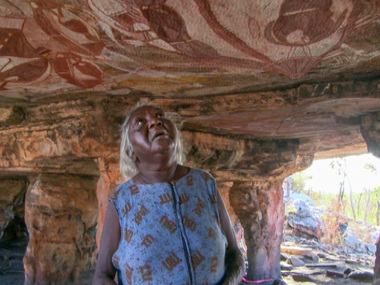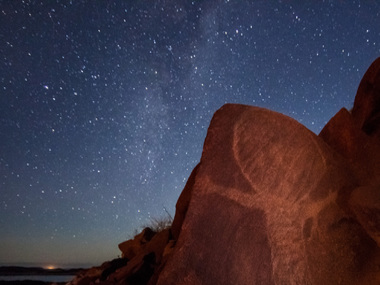THE IMPORTANCE OF BEING ERNIE

Jawoyn Elder, Margaret Katherine in Gabarnmung Rock Shelter, created by her Old People
Posted by Jeremy Eccles | 13.07.13
Dates:
14.07.13
: 04.08.13
The power of TV to educate and change minds is nowhere more apparent than in the new 4-part ABC TV series beginning on Sunday night. 'First Footsteps' will, hopefully achieve what the balefully accusatory 'First Australians' series failed to do – allowing viewers to come out admiring the immense achievements of Aboriginal Australia. For there's not a negative that I've come across yet in the series – though I suspect that some of the presenters' confident claims will be the subject of lively debate amongst archaeologists and anthropologists.
But when the main narrator is the beloved Ernie Dingo – at his most sober and earnest – few will have doubts at the time!
So Episode One covers the arrival of the Aborigines across the land bridges of southern Asia – the first of homo sapiens to leave Africa 70,000 years ago, travelling all the way round the coastline of Asia to arrive here 20,000 years later – when Europe was still in its Neanderthal stage. What impelled them to travel on – especially when they were faced by the final hurdle of 80 kms of open sea to make the last leap to the Great Southern Land – is beyond speculation, unfortunately.
Also beyond speculation in this series is the Great Debate over the 40 year old discoveries of Mungo Persons by Jim Bowler. Although he appears in the program to describe the magical moment when he found burnt bones at Lake Mungo and presumed they were animal – only to be told that he'd found evidence of the world's first human cremation, 26,000 years ago – there's no mention of the 'gracilis' nature of two of his early skull finds and the different, 'robust' nature of the third.
Hell, why confuse the issue when you've got pictures of an ochred skeleton which clearly shows evidence of Man having a spiritual life 30,000 years ago – for all we know, the world's first ritual?
And when you can back this up in Arnhemland with cave-wall imagery of Yingana, the Creation Mother, arriving in the Far North with dilly-bags full of generations of Kunwinjku, and a Traditional Owner to tell the story, why raise a doubt?
For this blend of science, lore, really moving use of old films of both ritual and the traditional life of tribal Aborigenes, access to meaningful cave art and great photography makes for an absolutely winning combination. Congratulations to Bentley Dean and Martin Butler, the team behind 'First Footsteps'.
But some of the dating is going to be controversial. There's passing mention of Aboriginal remains dating back 50,000 years – but no detail offered. And the delightful Jawoyn elder Margaret Katherine takes us to Gabarnmung Rock Shelter in Arnhemland to show us a painting of a big, flightless bird. For her, it's just evidence of the artistry of the Old People – making the strange creatures of this new land familiar by painting them. For archaeologist Ben Gunn, though it's key proof of his view that Australia's megafauna didn't get hunted to extinction the moment Aborigines arrived here, but survived on to be painted 14,000 years later. They were only wiped out by the arrival of the great Ice Age.
With Margaret Katherine there to link that unimaginable antiquity to the here and now: "My grandparents are here", she exclaims - delighted that these visitors can tell her that Gabarnmung wasn't created by wind erosion but by the Old People cutting away the rock and leaving a few pillars intact to hold it up - its small wonder that a French archaeologist can also marvel at his participation in this "living archaeology", compared to more sterile European practice.
Over in the West, the magnificent (but threatened) Burrup Peninsular (Murujuga) with its million petroglyphs can't be ignored - though the recent intrusion of an oil refinery and explosives plant are but lightly touched on. The world's first image of a human face is special enough; but the communication of the 25 to 35,000 year old Climbing Men image 800 kms inland into Martu Country is cause for even greater excitement. "Tools, artefacts, ceremony and ideas travelled extensively along the Songlines", extols archaeologist Peter Veth.
"They came, they saw, they adapted sustainably", is the message we carry into Episode Two – how Aborigines survived 15,000 years of cold and drought.
'Drought' would be a notion causing surprise to the authors of an article about Lake Mungo which I have, declaring "Towards the end of the last Ice Age some 20,000 years ago, the climate was cooler, with more rainfall, and areas like the (now) arid salt-bush plains of Western NSW were green woodlands, scattered with large freshwater lakes".
But in 'First Footprints', they're consistent in claiming that drought killed the megafauna, forced Aborigines up into the hills, caused a complete change in diet from meat to reptiles, grubs and grass seeds; and the need for the latter caused the invention of the grindstone. But 'knowing' was the optimum way to survive – so it was then that the Old People increasingly developed the mnemonics of the Law, the learning of which began with initiation.
And the Spinifex People of WA are on hand to lead us to Koonaldar Cave in the Nullarbor where annual initiation rites would have taken place over the aeons. Entering the womb of Mother Earth via a narrow vagina-like slit, our archaeologist guide recreates the dark, dank conditions in which boys would have been re-born as men and scratched their way up to the light – their finger-marks still in soft sandstone for him to amaze over. "We all came from here", intone the old men guiding him – though they, wisely, stay outside and sing rather than brave another re-birth!
And then the waters rose as the ice caps and glaciers melted. Episode 3 will reveal how Aborigines adapted to that change via art, ceremony and laws that are still extant.
ABC 1 is showing the series at 9.25pm on Sunday nights from tomorrow.
URL: See the ABC highlights here
Share this:
»  del.icio.us
»
del.icio.us
»  Digg it
»
Digg it
»  reddit
»
reddit
»  Google
»
Google
»  StumbleUpon
»
StumbleUpon
»  Technorati
»
Technorati
»  Facebook
Facebook
Contact Details

The First Man on 'First Footprints' - one of a million petroglyphs on the Burrup Peninsular/Murujuga

The megafauna bird, Genyornis Newtoni on an Arnhemland cave wall - or is it?
Further Research
News Tags: ABC TV | Australian archaeology | Burrup Peninsular | Ernie Dingo | First Footsteps | Jeremy Eccles | Mungo Man | rock art
News Categories: Blog | Event | Industry | Media | News | Other Event | Videos
Exhibition Archive
- 10.10.17 | TARNANTHI 2017
- 11.08.17 | Natsiaas 2017
- 20.07.17 | APY ART DOMINATES THE WYNNE
- 17.07.17 | Anangu Artist Wins $100,000 Prize
- 14.07.17 | The End of AAMU
- 11.07.17 | ART ACROSS THE COUNTRY
- 11.07.17 | TARNANTHI IN OCTOBER
- 05.07.17 | TJUNGUṈUTJA - from having come together
- 13.06.17 | Ghost-Nets Straddle the World
- 07.06.17 | Grayson Perry Going Indigenous?
- 05.06.17 | Barks Bigger than Ben Hur
- 27.05.17 | NGA QUINQUENNIAL 2017
- 21.05.17 | Blak Douglas Finds Home at the NGA
- 21.05.17 | BRIAN ROBINSON WINS HAZELHURST WOP
- 18.05.17 | PARRTJIMA 2.0
Advertising

